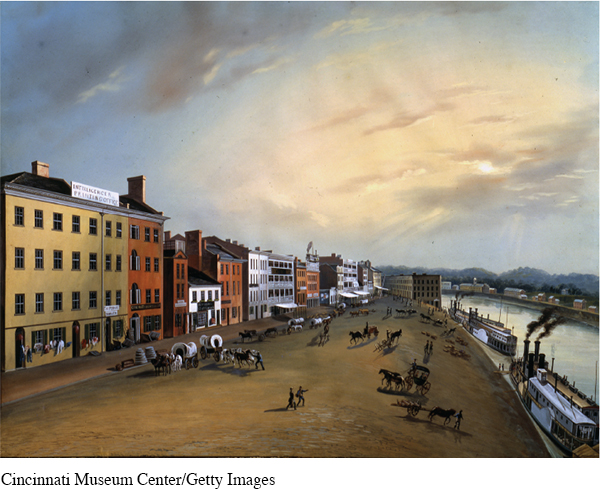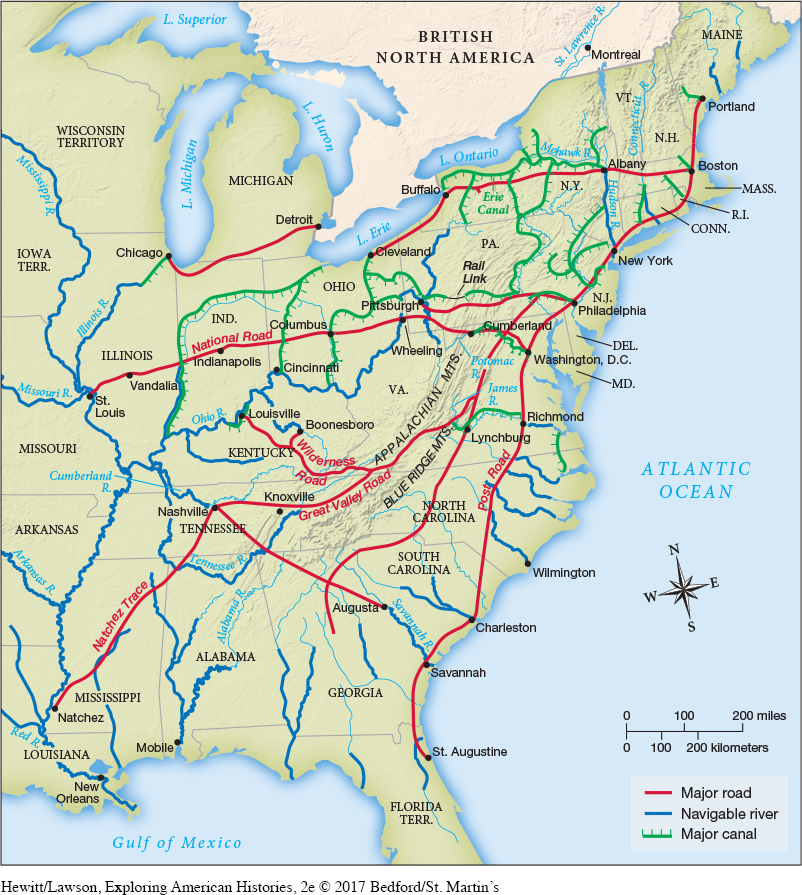Governments Fuel Economic Growth
In 1800 Thomas Jefferson captured the presidency by advocating a reduction in federal powers and a renewed emphasis on the needs of small farmers and workingmen. Once in power, however, Jefferson and his Democratic-Republican supporters faced a series of economic and political developments that led many of them to embrace a loose interpretation of the U.S. Constitution and support federal efforts to aid economic growth.
Population growth and commercial expansion encouraged these federal efforts. In 1811 the first steamboat traveled down the Mississippi from the Ohio River to New Orleans; over the next decade, steamboat traffic expanded. This development helped western and southern residents but hurt trade on overland routes between northeastern seaports and the Ohio River valley. The federal government began construction of the Cumberland Road in 1811 to reestablish this regional connection by linking Maryland and Ohio. Congress passed additional bills to fund ambitious federal transportation projects, but President Madison vetoed much of this legislation, believing that it overstepped even a loose interpretation of the Constitution.
After the War of 1812, however, Democratic-Republican representative Henry Clay of Kentucky sketched out a coordinated plan to promote U.S. economic growth and advance commercial ties throughout the nation. Called the American System, it combined federally funded internal improvements, such as roads and canals, to aid farmers and merchants with federal tariffs to protect U.S. manufacturing. Western expansion fueled demand for these internal improvements. The non-Indian population west of the Appalachian Mountains more than doubled between 1810 and 1820, from 1,080,000 to 2,234,000. Many veterans of the War of 1812 received 160-acre parcels of land in the region as payment for service and settled there. Congress admitted four new states to the Union in just four years: Indiana (1816), Mississippi (1817), Illinois (1818), and Alabama (1819).

Congress also negotiated with Indian nations to secure trade routes farther west. In the 1810s, Americans began trading along an ancient trail from Missouri to Santa Fe, a town in northern Mexico. But the trail cut across territory claimed by the Osage Indians. In 1825 Congress approved a treaty with the Osage to guarantee right of way for U.S. merchants. In the following decade, the Santa Fe Trail became a critical route for commerce between the United States and Mexico.
East of the Appalachian Mountains, state governments funded most internal improvement projects. The most significant of these was New York’s Erie Canal, a 363-mile waterway stretching from the Mohawk River to Buffalo that was completed in 1825. Tolls on the Erie Canal quickly repaid the tremendous cost of its construction. Freight charges and shipping times plunged. And by linking western farmers to the Hudson River, the Erie Canal ensured that New York City became the nation’s premier seaport (Map 9.2).

The Erie Canal’s success inspired hundreds of similar projects in other states. Canals carried manufactured goods from New England and the Middle Atlantic states to rural households in the Ohio River valley. Western farmers, in turn, shipped agricultural products back east. Canals also linked smaller cities within Pennsylvania and Ohio, facilitating the rise of commercial and manufacturing centers like Harrisburg, Pittsburgh, and Cincinnati. Canals also allowed vast quantities of coal to be transported out of the Allegheny Mountains, fueling industrial development throughout the Northeast.
Exploring American HistoriesPrinted Page 283
Exploring American Histories Value EditionPrinted Page 211
Chapter Timeline